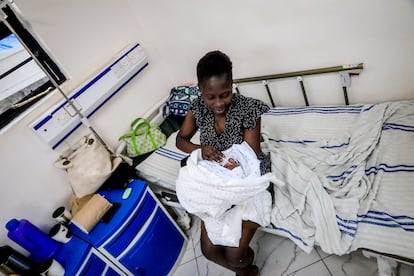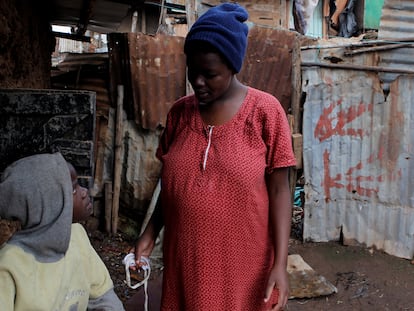Seven simple innovations that could save the lives of two million pregnant women and babies
A study by the Bill and Melinda Gates Foundation states that the world is experiencing an epidemic of maternal and child mortality

Seven medical innovations or treatments, most of them inexpensive and easy to implement, could significantly reduce maternal and infant deaths around the world, particularly in sub-Saharan Africa and South Asia. This is the conclusion of the 2023 Goalkeepers Report published by the Bill and Melinda Gates Foundation this Tuesday. “By making new innovations accessible to those who need them most, 2 million additional lives could be saved by 2030 — and 6.4 million lives by 2040,” estimates the philanthropic organization in its annual report, which focuses on maternal and child mortality, whose progress has become stagnant since 2016 and even increased in some countries, including the United States.
Among these innovations are the rapid diagnosis of postpartum hemorrhage, an intravenous infusion of iron against anemia, a probiotic supplement for babies, antenatal corticosteroids (anti-inflammatories) for women who will give birth prematurely, azithromycin (an antibiotic) to prevent infections, and an AI-enabled ultrasound device to monitor high-risk patients in low-resource places.
In 2015, world leaders agreed on 17 Sustainable Development Goals with an eye toward 2030. The year 2023 marks the halfway point to achieving those goals and, in the case of maternal, child and neonatal mortality, the data indicate that there is still a long way to go. The goal was to end all preventable child deaths by 2030 and reduce maternal mortality to 70 out of every 100,000 births, but that has not happened. Every day, 800 women around the world die from reasons related to pregnancy and childbirth. That is, one every two minutes. According to the UN, 70% of these deaths occur in sub-Saharan Africa. In addition, every year approximately five million children die before their fifth birthday, and nearly two million more are stillborn.
This happens despite the fact that there has never been so much scientific knowledge on maternal and child health: “Researchers have learned more about the health of mothers and babies over the past 10 years than they did in the century before that,” the report states. The problem is that the solutions do not reach those who need them most. The authors even speak of an “epidemic” of maternal and child mortality, and not only in low-income countries: in the United States, for instance, mortality among Black mothers has doubled since 1999. “American women are more than three times more likely to die from childbirth than women in almost every other wealthy country. But, as I noted earlier, the biggest crisis is among Black and Indigenous women,” writes Melinda French Gates.
In the 2000s, indicators of human well-being such as poverty or education improved substantially, and it was precisely maternal and child health what made the most progress. This was possible, in part, because several international organizations had set ambitious goals; these, however, were curtailed after 2016 and ended up stagnating with the arrival of the Covid-19 pandemic. In some countries, like Venezuela or the United States, the situation has even worsened, according to the report.
Three low-cost lifesavers
According to Melinda French Gates, three inexpensive innovations can prevent thousands of women in low- and middle-income countries from dying during pregnancy and childbirth: a new treatment for postpartum hemorrhage, the use of the antibiotic azithromycin to prevent infections, and intravenous infusions of iron for cases of anemia.
Postpartum hemorrhage (PPH), which occurs when a woman loses more than half a liter of blood within 24 hours of childbirth, is the number one cause of maternal death. The World Health Organization (WHO) estimates that it affects 14 million women a year, killing 70,000, particularly in low-income countries. In impoverished countries, the main problem is realizing that a significant loss of blood is taking place. In many places this is only estimated visually, and thousands of women die without receiving the treatment that could save them.
The Gates Foundation proposes a simple, low-cost way to assess this blood loss: a calibrated obstetric drape that looks like a V-shaped plastic bag, which is hung on the edge of the patient’s bed so the blood falls into it and rises like the mercury in a thermometer. That is a quick visual gauge that can alert healthcare personnel in time. Furthermore, instead of sequentially applying the five treatments to stop bleeding (uterine massage, oxytocic drugs, tranexamic acid, IV fluids and genital-tract examination), they propose grouping them all together. In a study called E-MOTIVE, Nigerian obstetrician-gynecologist Hadiza Galadanci and a team of researchers from four African countries with a high maternal mortality rate found that using the drapes and following the updated guidelines managed to decrease cases of severe bleeding by a remarkable 60%.
Another of the proposed changes is the treatment of anemia, which affects 37% of pregnant women (although in some areas of the world, such as South Asia, it can go up to 80%) and increases the chances of hemorrhage during childbirth. Diagnosing it during pregnancy is essential, but instead of treating it with oral iron supplements that must be taken for 180 days, Bosede Afolabi, a Nigerian obstetrician and researcher, is working to implement a promising new intervention in her country: a single intravenous infusion of iron that takes 15 minutes and can replenish a woman’s iron reserves during pregnancy.
Another of the main causes of maternal mortality is infection. In recent years, researchers have discovered that one of the most promising new ways to prevent infections during pregnancy is one of the most used antibiotics in the world: azithromycin. In a trial carried out in sub-Saharan Africa, it reduced cases of sepsis (an extreme inflammatory reaction) by one third.
“These breakthroughs aren’t silver bullets on their own — they require countries to keep recruiting, training, and fairly compensating health care workers, especially midwives, and building more resilient health care systems. But together, they can save the lives of thousands of women every year,” reflects Melinda French Gates.
The baby knowledge boom
“Over the past decade, the field of child health has moved faster and farther than I thought I’d see in my lifetime,” writes Bill Gates, highlighting the launch of three Gates Foundation programs to carry out research on the deaths of children and newborns, in order to prevent them: CHAMPS (Child Health and Mortality Prevention Surveillance); PERCH, which analyzes the causes of childhood pneumonia; and GEMS, for diarrheal diseases.
Ten years ago, he explains, “any record of a child’s death would generally list one of the four most common causes: diarrhea, malnutrition, pneumonia, or premature birth.” However, he continues, “each was a vast ocean of different illnesses, with scores of different causes and cures. Pneumonia, for example, is linked to more than 200 types of pathogens.”
The collection of data carried out in recent years — taking blood and tissue samples from children who had died and comparing cases — has revealed that some pathogens were less likely than expected, such as the one that causes whooping cough, while others were more common, such as Klebsiella, which is more difficult to treat. The new information about this last bacteria “is leading doctors to change what antibiotics they use,” explains Bill Gates. This is what he refers to as the baby knowledge boom. “Thanks to studies like CHAMPS, GEMS and PERCH, the medical field has begun to understand precisely when and why some babies are dying, which allows them to keep others alive,” he stresses.
Another example that Gates highlights is how doctors help premature babies breathe by giving antenatal corticosteroids (ACS) to pregnant mothers who are going to give birth prematurely. According to the foundation’s calculations, “ACS could save the lives of 144,000 infants in sub-Saharan Africa and South Asia by 2030 and nearly 400,000 by 2040.” Probiotic supplements with bifidobacteria (bacteria that live in the digestive system and help break down milk sugars) also reduce the risk of death or serious illness in premature babies.
Sign up for our weekly newsletter to get more English-language news coverage from EL PAÍS USA Edition
Tu suscripción se está usando en otro dispositivo
¿Quieres añadir otro usuario a tu suscripción?
Si continúas leyendo en este dispositivo, no se podrá leer en el otro.
FlechaTu suscripción se está usando en otro dispositivo y solo puedes acceder a EL PAÍS desde un dispositivo a la vez.
Si quieres compartir tu cuenta, cambia tu suscripción a la modalidad Premium, así podrás añadir otro usuario. Cada uno accederá con su propia cuenta de email, lo que os permitirá personalizar vuestra experiencia en EL PAÍS.
¿Tienes una suscripción de empresa? Accede aquí para contratar más cuentas.
En el caso de no saber quién está usando tu cuenta, te recomendamos cambiar tu contraseña aquí.
Si decides continuar compartiendo tu cuenta, este mensaje se mostrará en tu dispositivo y en el de la otra persona que está usando tu cuenta de forma indefinida, afectando a tu experiencia de lectura. Puedes consultar aquí los términos y condiciones de la suscripción digital.
More information
Archived In
Últimas noticias
Most viewed
- Sinaloa Cartel war is taking its toll on Los Chapitos
- Oona Chaplin: ‘I told James Cameron that I was living in a treehouse and starting a permaculture project with a friend’
- Reinhard Genzel, Nobel laureate in physics: ‘One-minute videos will never give you the truth’
- Why the price of coffee has skyrocketed: from Brazilian plantations to specialty coffee houses
- Silver prices are going crazy: This is what’s fueling the rally










































